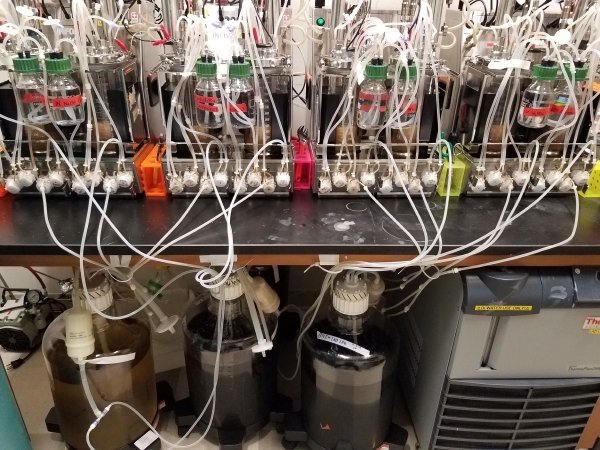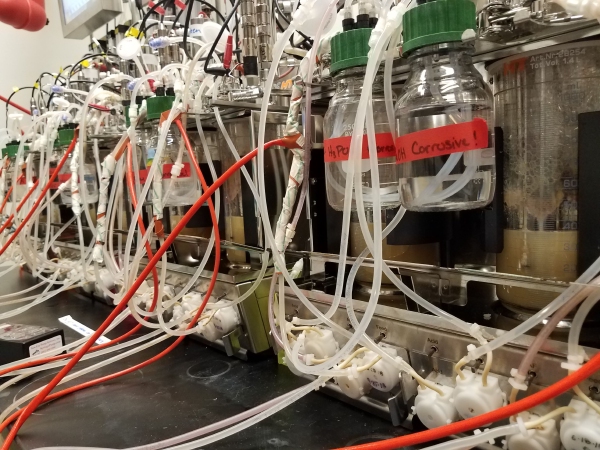This talk was delivered at the Society for Literature, Science, and the Arts (SLSA) in November 2019 as part of a series of panels on the microbiome. The first two panels in the stream were organized by Kym Weed (UNC-CH) and Melissa Wills (UC Davis), who kindly incorporated another pair of panels I organized with the S-1 Speculative Sensation Lab at Duke.
Fecal Froths and Sourdough Starters: A Non-Phenomenology of Alimentation
The simplest animals are merely an intestinal canal.
— G. W. F. Hegel, Encyclopedia of the Philosophical Sciences §354 Zusatz
Fecal Froths

In the well-lit, narrow corridors of the David Lab at Duke University, eight translucent cannisters bubble their brown slurries. The smell is faint but familiar. Digital sensors monitor the microbial stews, while tubes carrying metabolites and inert gases maintain their operational closure. These are fecal froths, and they are what historian of science Hans-Jörg Rheinberger calls epistemic things: the element of the experimental system under investigation. They have become a crucial method, principal investigator Lawrence David writes, “for isolating and culturing human gut microbiomes.” As Georges Canguilhem points out, the biological object of study resists its transformation into an artifact native to the laboratory. Just so, David explains that his lab is working with “artificial gut models,” which are isolated from “host processes such as immune response or circadian rhythms.” The fecal froth represents a domestication of microbes alternative to that of the enteric ecologies that are our guts.

So, how does this work? By taking a stool sample from a human subject, the microbiota in that sample may then be cultured and monitored as the investigators adjust variables. We were told by our doctoral-student guide that it matters how the sample is taken (Is it from wiping? Is it from the exterior or the interior of the stool?) and how the sample is prepared (Is it blended or stirred?). Above all, this in vitro method intends to resolve two significant challenges to studying the human gut microbiome. One is accessing it in the first place. Another is the glut of data that comes with the genomic approach of sequencing the DNA of a stool sample. Instead of identifying individual taxonomies of host microbiota, an artificial gut model treats the microbiome as a black-box so as to ascertain its function as a processor of metabolites.
There’s more to the David Lab than in vitro gut microbiomes. They also construct computational models, which the genomic approach requires, and run human studies via an iOS-based self-tracking application of their design. For instance, a year-long study of two subjects indicated significant fluctuations in gut and saliva microbiota coinciding with a change in diet—one subject spent a month and a half in Southeast Asia—and food poisoning—the other subject contracted Salmonella. All this research is headed toward microbiome engineering—human and otherwise. The Lab intends to build “a platform to personalize prebiotic treatments to individuals based on their gut microbiota and lifestyle.” This, David expects, will in turn “have applications for bacterial communities outside the human gut” such as in agriculture, chemical synthesis, and toxic waste cleanup. Human health interventions focused on microbiota may therefore expand into a much broader bioengineering project.
Since I suspect y’all are wondering about their results, I’ll summarize: While the underwriters for their research grants hope for marketable treatments that could be tailored to the consumer-patient, we were told that the evidence strongly indicates that most of us in the so-called developed world ought simply to eat a lot more fiber. Now, there is another result wrapped up in the very method employed: namely, the exteriorization of an environment, internal to the body, as part of the creation of an artifact, which may then be objectified through measurement and analysis, knowledge claims, and the citational networks that establish scientific theory. I use the word “exteriorization” to echo André Leroi-Gourhan’s paleoanthropology and Bernard Stiegler’s philosophical interpretation of it. It’s another interesting connection to make, but one which I do not have time to follow. Perhaps we could take it up in the Q&A. Just note how the David Lab, and microbiome engineering more generally, exteriorize the symbiotic functioning of microbiota and their hosts so as to interiorize whatever utility is made possible by the former process.
Sourdough Starters
A few days ago, the jar seemed merely to contain equal portions by weight of flour and water. Left on the counter and loosely covered, however, bubbles soon manifested, and today a smell surfaces from the viscous, brown paste. Its scent is just as familiar as that of the David Lab: tangy and a little pungent—compelling rather than off-putting. This fungal colony is a sourdough starter. Here, as in the microbiome laboratory, microbes have been domesticated. Unlike the fecal froths, which transfer a multitude of already internalized microbiota to an artifactual environment, the sourdough starter cultivates omnipresent wild yeast.
Numerous examples of fermentation present a similar microbial cooperation: brewing surely comes to mind, as does the creation of fish sauce. The latter is particularly salient, for the enzymes and bacteria in the viscera of fish consume the fish from inside out. After a few months, but usually a year, a salty, pungent liquid can be strained from the goop for cooking.
The sourdough starter stands apart from these other fermentations for its longevity. After the first several days of getting it going, one need only feed it every month or two depending on the ambient temperature. I would feed mine in order to replenish it when baking. Unlike industrial yeast, with which a dough will prove in a matter of hours, with a sourdough starter one must ideally wait overnight for adequate fermentation. So I will roll it out and knead it two or three times, each time returning my sourdough to its warm, dark covering to grow. It’s a nice pace: like the intermittent attention-sinks our phones provide, except it actually feels productive. My culinary pace is dictated by the metabolic rate of my fungal friends, or, if you prefer the language of wine marketing, of the terroir. Just so, Sebastian Abrahamsson discusses the wholly situational determination of the normativities of time spent growing, producing, transporting, cooking, consuming, and digesting food. He uses the Swedish word “lagom” to refer to his grandmother’s request that those at her table take their time to eat and then to rest while digesting. But lagom is never predetermined To Abrahamsson’s many and various examples of adaptive and adapting eaters, I add the unicellular fungi in the sourdough starter, which eats and reproduces at its own pace.
Fecal froths and sourdough starters both render an environmental process into a consciously registered phenomenon. They do so through an intentional mediation of heterogeneous phenomena: on one hand, the microscopic activity of microbiota; on the other hand, the relatively macroscopic activity of the scientist or baker. I refer to both instances of cultivated microbial digestions as environmental because in either case what was extant as the relative, presupposed ground for existence has been foregrounded and put into direct relation with some of the phenomena so grounded. More to the point, that grounding relation has been intentionally modified. Thus, both the froth and the starter exhibit the features of technology: an intentional mediation of mediation that synthesizes disparate phenomena across orders of magnitude. Gilbert Simondon articulates this scalar syncretism in a 1970 course lecture as follows: “The laboratory”—and, I would add, the kitchen—“is a node of orders of magnitude;” it exists on the human scale, yet “it is in correspondence with the cosmos, spatially by its construction, temporally by the synchrony between operations that unfold there and the coming together of the stars or other influences seized at their maximum.”
Alimentary Philosophy
These two exemplary scenes—one of contemporary scientific experimentation, the other of an ancient culinary technique—depict complementary moments of the alimentary process. Alimentation encapsulates the three component processes of eating: ingestion, digestion, and excretion. Prior to our own ingestion of leavened bread, a chain of microbiotic alimentations has occurred to prepare it. The same may be said of any food, of course, and not just those that are fermented. After all, under the umbrella of microbiome engineering falls the various niches of the human microbiome, the soil microbiome, as well as both native and synthetic “root-associated microbiota transplants.” The earth we walk upon churns with microbial alimentation. Within the animal’s sequence of digestion, the gut microbiome accomplishes innumerable component alimentations. Ingestion and digestion are already excretion. An artificial gut model receives the end moment of alimentation, excretion, and forestalls it, revitalizing the digestive moment.
There’s a lot that can be done by staging these two scenes together, as I’m sure an audience at SLSA recognizes. I focus on the long tradition of conceptual exchange between science, literature, and philosophy. Today, I shall take up a few passages from Hegel’s Philosophy of Nature, which is the second book in his Encyclopaedia of Philosophical Sciences (1817/1830). The reason for turning to this strange and exhilarating text is that Hegel puts sensation and alimentation on equal footing. As J. N. Findlay puts it in his foreword to the volume: “It is curious and touching that a dialectical idealism such as Hegel’s should lay so much stress on eating” (xxiii). Briefly put, the microbially expanded picture of macro-organisms’ reliance on other organisms’ processes intensifies Hegel’s own conception of nature as featuring stages of increasingly nested levels of self-determination.
It’s a common refrain: the more complex the structure, the wider autonomy it has for expressing its existence; but said autonomy always depends on external determinations stemming from both other living beings and physico-chemical processes. Living beings “always sublate the nature of what is chemical” into “a lasting unrest” (394). In this regard, Hegel’s theoretical approach anticipates what Bergson, and after him Simondon, both call “dilation.” I mention “dilation” because I expect Bergson and Simondon are more likely reference points for you than Hegel’s philosophy of nature. The idea is that when the living being develops on the basis of finite physico-chemical processes, it does not instantiate a hierarchical break with the latter. Rather, the organism’s self-sustaining process postpones the completion (or termination) of finite chemical interaction and draws it out by incorporating it into the maintainance of a relatively more dynamic, self-relating structure.
Central to organic process is the assimilation of the external world (e.g. inhalation-exhalation and alimentation). Assimilation is as much the instantiation of this mutually defined distinction between self and other as it is the overcoming of this distiction. Each of the various assimilations exhibit in different manners the animal’s relation to itself, under the conditions of external material, whereby that which is external to the living organism is transformed through and into the process that it itself is. In digestion, the ingested non-organic material becomes, to the extent that it can, identical with the consuming organism. Take note that the external “non-organic nature” Hegel talks about includes other organisms. It is defined as a relative term within assimilation in opposition to the organism. Things are external to the animal insofar as they participate in the animal’s “own process, this entanglement with the outer thing” (404). (In this Hegel prefigures von Uexkull’s notion of Umwelt.)
The first assimilation Hegel describes is called “the theoretical process.” This is the ideal reflection into self: in a word, sensation. The next process of assimilation discussed is the “real process or practical relationship,” for which “the alimentary process is the main thing.” In these sections, Hegel makes a wide variety of claims, from silly to obliquely prescient (as an example of the silly, he claims the animal defecates because it lacks in self-confidence and so abandons its attempt to overcome its difference with the food consumed; as for the prescient, Hegel anticipates the gut-brain axis and the embodiment of affect when linking anger to bile entering the stomach). The main takeaway for this little talk is how digestion instantiates in a real, practical way, the same process of assimilation by which the organism senses its world. Even the skin, for Hegel, is initially, i.e. for plants, “the universal digestive organ” because it absorbs sunlight and water. Thus, the feeling of the environment contributes the non-organic moment to the organism’s self-feeling, that is, its reproduction through externality. With animals, the skin and internal organs differentiate into specific modes of opposition to, and assimilation of, external nature. Sensation, like alimentation, involves its own kind of excretion, which takes the form of outward-directed behavior. Both sensation and digestion reproduce the organism by way of the particular oppositions the organism defines for itself.
Taking to heart the profound and multifarious roles of microbiota in multicellular biology, the self-externality of organic activity becomes much more extensive than the metabolizing of external matter through the life process. It also shows how limiting is Hegel’s language of anger and opposition when describing alimentation. Whereas Hegel typifies the “presupposed world” of the organism as both “its non-organic nature” and “already in existence,” we today would update this to be a thoroughly and necessarily organic nature—organic in Hegel’s sense of nested self-sustaining processes. The environment is microbial, from the atmosphere we breathe and surfaces we touch to the multiple ecological niches within and on our bodies. This is doubly so in animal bodies: for in addition to an animal’s microbiome, there is its ancestral symbiogeneses: the evolutionary theory that the first eukaryotic cells developed from prokaryotic cells ingesting or otherwise enveloping others, thereby establishing the existence discrete organelles within the cellular membrane. This is what Myra Hird, following Lynn Margulis, fittingly calls “failed digestion.”
Cultivation and Invention
Lastly, we should update Hegel’s assumption that the presupposed world is “already in existence.” For this, I turn to the third process of assimilation, which Hegel interchangeably calls the constructive instinct as well as the artistic impulse. It unifies “the ideal theoretical process [i.e. sensation] and the real process of digestion” into a process of “adapting its [the animal’s] environment to its own needs.” Nests, lairs, shelters, spider webs, caterpillar cocoons, and birdsong are all referred to by Hegel as forms of excrement, “fashioned by the creature to satisfy its need.” Again, Hegel analogizes living process in general with alimentation. Life is assimilation, and its model is digestion. With sensation, the excretion was behavior. With the constructive instinct, the excretion is the satisfaction of a need projected via the organism’s intention onto the world. In some cases, constructive assimilation is alimentation. Human breast milk, for instance, contains a particular sugar that fosters in the infant’s gut a beneficial strain of bacteria appropriately named Bifidobacterium infantis. As popular science writer Ed Yong puts it: “a breastfeeding mother isn’t just feeding a baby but also setting up an entire world.”
Fecal froths and sourdough starters exemplify how a wide range of microbiota not only contribute to the production of worlds but also participate in technologies for intentionally refashioning those worlds further. Each technological practice integrates microbial cultures with human culture—indeed, they contribute to constructing the latter through such integrations. As Simondon argues, at the historical and etymological roots of culture is cultivation: that is, the modification of a “living being’s environment,” which in turn often modifies the animal (as opposed to husbandry, which acts upon the animal directly). From this perspective, microbiome science expands the scope of what we recognize as cultivation to include the creation of environments that foster a concentrated population of selected microbiota. Beyond livestock and crops, humans have long been cultivating the microbiomes that inhabit those creatures (that is, indirectly) and that make fermentation possible (that is, directly). Today, you can buy kits to genetically engineer brewer’s yeast to make fluorescent beer.

I have been keen to point out the technological nature of these microbial cultivations in order to highlight how consciousness intentionally engages with nonhuman, nonconscious sensations. A Hegel-inspired alimentary philosophy implicates human phenomenology within the multifarious digestions that is our biome in process. I think that Hegel can be read as replacing Kant’s a priori conditions of possible experience with a contingently interlocking system of alimentations. The outcome, however, is not Absolute Spirit contemplating the logical necessity of its emergence but, rather, an experimental field for intervening in the grounds of possible experience. By inventing a novel synthesis of human experience with its grounding alimentations, the later circle back to the consciousness that was involved in their invention and expand its phenomenological purview. (Or, to use a Hegelian term, they infect it.) Simondon explains, in language reminiscent of his teacher Georges Canguilhem, that a modified environment in turn “offers [the organism] a new field of action, demanding a new adaptation and arousing new needs.”
It’s digestion all the way down.